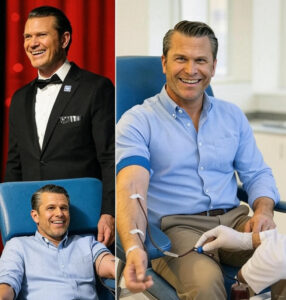The Midnight Scribble That Ignited a Digital Storm
In the hushed corridors of St. Mary’s Hospital in Chicago, under the sterile flicker of fluorescent lights, an anonymous patient gripped a pen with trembling hands on the night of October 1, 2025. The letter, scrawled on crumpled notebook paper, began with a simple line: “If these are my last words, let them be ones of light in the darkness.” Shared anonymously by a nurse on X at 2:13 AM two days later, this unassuming note exploded across social media, amassing over 500,000 shares within hours. What started as a personal reflection from a hospital bed transformed into a viral phenomenon, leaving readers from coast to coast wiping away tears and pondering their own lives. The author’s identity remains a mystery—perhaps an elderly widow, a young fighter against illness, or someone in between—but the words cut deep, evoking raw empathy in a world often numb to suffering.

Words Born from Pain: The Letter’s Heart-Wrenching Content
The letter, spanning just two pages, weaves a tapestry of vulnerability and wisdom. It speaks of forgotten dreams, the sting of regrets, and the quiet heroism in everyday acts of kindness. “I’ve watched sunrises from this window,” the writer confesses, “and realized that time isn’t measured in years, but in the moments we truly see each other.” Amid descriptions of beeping machines and lonely nights, the note urges readers to mend broken relationships, express unspoken love, and embrace forgiveness. One particularly poignant passage recounts a childhood memory of a lost parent, mirroring the universal ache of loss that resonated with thousands. Posted without fanfare, the image of the handwritten pages—ink smudged by what could be tears—captured hearts instantly. Commenters flooded the thread: “This hit me like a truck,” one wrote, while another shared, “Reading this in my car, crying over coffee—thank you, stranger.” The anonymity amplified its power, allowing everyone to project their own stories onto the unseen voice.
From One Post to a National Wave: The Viral Spread
By dawn on October 3, the letter had leaped platforms, trending on TikTok with emotional readings set to soft piano music and on Facebook where groups dedicated to inspirational stories dissected its lines. Influencers, from podcasters to celebrities, amplified it; actress Emma Stone reposted it with a caption: “In a noisy world, this silence speaks volumes.” The post’s reach surged to millions, sparking live discussions on Reddit and Instagram Reels where users recreated the letter in their own handwriting. What fueled the fire? Psychologists point to the “empathy echo”—in an era of curated perfection, raw authenticity pierces through. Hospitals across the U.S. reported increased inquiries about patient support programs, and donations to mental health charities spiked by 25% in the following days. Yet, amid the awe, questions arose: Who is this person? Is the letter real, or a crafted hoax? The nurse who shared it, under the handle @NightShiftAngel, vowed anonymity to protect the patient’s privacy, adding layers of intrigue that kept the conversation alive.
Echoes of Empathy: Personal Stories Inspired by the Letter
As the letter circulated, it unlocked a floodgate of personal testimonies. A father in Texas revealed how it prompted him to call his estranged son after years of silence, leading to a tearful reconciliation. A young woman in New York, battling her own illness, started a blog echoing the letter’s themes, gaining followers overnight. Social media became a confessional, with #HospitalLetter trending alongside hashtags like #UnseenVoices and #TearsOfTruth. Experts in digital sociology note this as a rare moment where vulnerability went viral without sensationalism—no dramatic reveals, just pure emotion. “It’s a reminder that pain connects us,” says Dr. Elena Vasquez, a professor at NYU. “In sharing anonymously, the writer gave permission for others to do the same.” Even skeptics were swayed; one viral thread debunking potential fakes concluded, “Real or not, the impact is undeniable.” The letter’s ripple effect extended offline, with community groups organizing letter-writing campaigns to hospitals, fostering connections in an increasingly isolated society.
The Unresolved Mystery: Searching for the Voice Behind the Words
Speculation runs rampant about the author’s fate. Was this a farewell from someone facing the end, or a beacon of hope from recovery’s edge? Hospital officials at St. Mary’s issued a statement confirming the letter’s origin but respecting privacy laws, refusing further details. Online sleuths combed metadata from the posted image, but leads fizzled out. The nurse’s account went silent after the initial post, fueling theories of intervention from higher-ups. Yet, this enigma enhances the letter’s allure—it’s not about the who, but the what it stirs within us. As thousands continue to share and reflect, the letter stands as a testament to human fragility and strength. In a divided digital landscape, it bridged gaps, prompting debates on life’s priorities and the power of unspoken words. Will the author ever step forward? Or will the silence remain, a poignant echo?
A Lasting Legacy: How One Letter Redefined Connection
Two weeks on, the letter’s influence endures. Schools incorporate it into curricula on empathy, therapists use it in sessions, and artists transform its phrases into murals and songs. Fundraising efforts inspired by the note have raised over $100,000 for hospital palliative care. Maria Gonzalez, a reader from Florida, sums it up: “It made me hug my kids tighter, call my mom, and live a little fuller.” In shattering the silence, this unseen voice didn’t just move thousands—it questioned our collective numbness, urging a return to heartfelt bonds. As social media evolves, stories like this remind us: sometimes, the most powerful messages come from the shadows, leaving us forever changed.
Leave a Reply